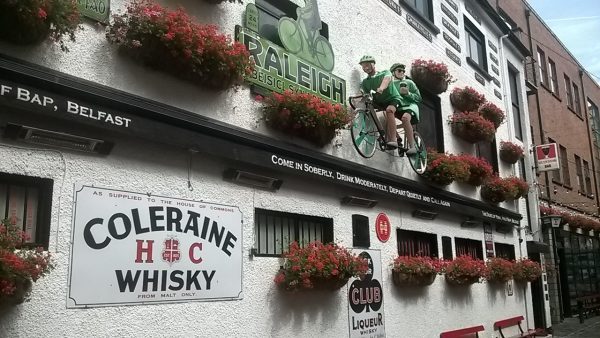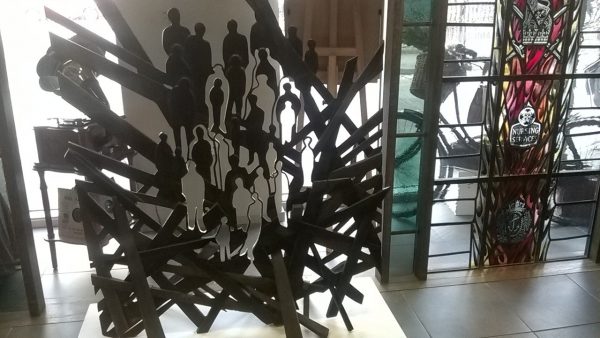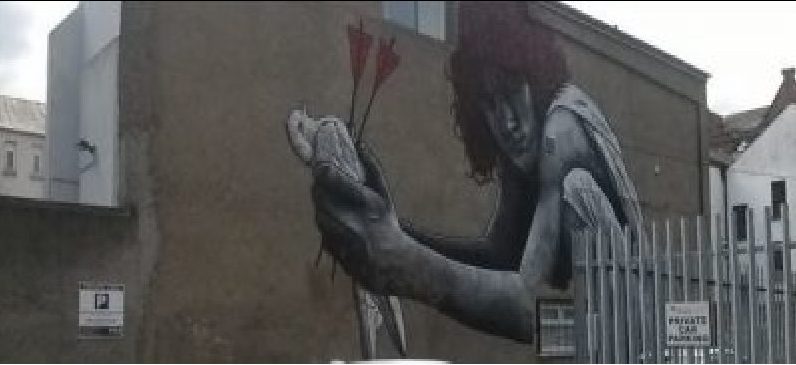Many people asked me why my friend and I would decide to have a break in Belfast rather than have a sunny escape. Being interested in politics and having visited southern Ireland several times, we wanted to find out more about Northern Ireland and its history, .

While trying to persuade the Rye News editor that I should write about the visit, which I felt was worth talking about, I was reminded that we usually try and have a Rye or surrounding connection. Initially I only came up with the fact that at the Rye Arts Festival a great Irish folk group, Lynched, will be performing. But, since talking about the extraordinary and educational few days in Belfast to others on my return, one person from Rye (there may of course be more) told me that he was actually in Belfast in the 70’s which was a most difficult time for all concerned, trying to stop the sectarian fighting.
On our first day, July 11, we decided to hire a taxi that provided “political tours”. The taxi driver spoke to us about Northern Ireland history, but I still feel I need to absorb by reading a book. What was remarkable about the driver was that, while we felt that there was a hint of an underlying anger, he was presenting the situation in as neutral a way as possible, giving reasons on both sides for their behaviour then and now, as well as explaining the role the British army played in the past.

After seeing part of the city he took us to the “peace wall”. I expected a small bit of brickwork with a positive message of the present fragile peace. By the time we got there he had explained that the wall divided the Catholic and Protestant area with two gates that are closed at 10pm each night. If anyone wanted to return later they would have to go into the centre of Protestant Belfast and make their way back from there. We were a bit shocked. However, apparently the barrier which grew over the years from a high fence to a solid structure, stopped the violence and made people who lived in the houses on either side feel safer. There are now 99 interfaces – or peace walls – in Belfast. Many of them have been put up since the ceasefire in 1994 at the request of the locals. Recently, the International Fund for Ireland, an independent organisation promoting reconciliation, announced they will make available a 2million project aimed at bringing down the Belfast peace walls.

The wall on the Protestant side was full of wonderful murals and graffiti. We were shown Bill Clinton’s signature as he was involved in the peace process.
We happened to be there when the Orange march took place and were warned to be careful. We did join the crowd lining the streets for a short time and it seems that the talks between all parties and community projects have paid off. Apparently it was the most peaceful march for many years and the drummers, as directed, showed respect when passing Catholic churches by keeping the drumming very low key.
Throughout the city we came across many murals, one more beautiful than another and most very personal to the artist. We also went to one of the oldest and most beautiful pubs, the Duke of York.

Everyone we encountered, Irish people in the street, the European and local workers in the hotel, the coach driver who also enlightened us about the present politics, visitors we came across on our journey to the Giant Causeway, all were wonderfully open and friendly. We talked to several of the foreign workers, Polish, Italian and Romanian who told us that they had come to Belfast to study, got a job and made a life and were paying their taxes. They all worried about their status after the Brexit decision.
The Giant’s Causeway itself was an amazing natural architectural feat. It is an area of about 40,000 interlocking basalt columns, the result of an ancient volcanic eruption. Located in County Antrim on the north east coast of Northern Ireland it was declared a World Heritage Site by UNESCO in 1986 and a national nature reserve in 1987. Most of the columns are hexagonal. The tallest are about 12 meters (39 feet). The Giant Causeway has become one of the most popular tourist attraction in Northern Ireland.

We also visited the Titanic museum which was another eye opener as it showed the hard work and the deaths that happened when building the ship which was supposed to surpass any other. Apart from the wonderful architecture of the building, the technology within was surprising. There was a funicular with four cars which took you from the top floor down three flights in a spiral with TV screens along the way showing the workers battling away making it the best ship possible.
On the last day we went to a war museum which concentrated particularly on the Somme. Also it explained and showed the devastation in Belfast after it was blitzed three times in WW2.
If you read above with interest you might understand why we chose Belfast with its complexities and the wonderful people we encountered.
Photos: Heidi Foster



